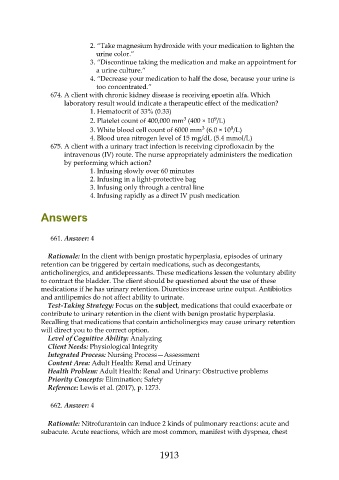Page 1913 - Saunders Comprehensive Review For NCLEX-RN
P. 1913
2. “Take magnesium hydroxide with your medication to lighten the
urine color.”
3. “Discontinue taking the medication and make an appointment for
a urine culture.”
4. “Decrease your medication to half the dose, because your urine is
too concentrated.”
674. A client with chronic kidney disease is receiving epoetin alfa. Which
laboratory result would indicate a therapeutic effect of the medication?
1. Hematocrit of 33% (0.33)
9
3
2. Platelet count of 400,000 mm (400 × 10 /L)
9
3
3. White blood cell count of 6000 mm (6.0 × 10 /L)
4. Blood urea nitrogen level of 15 mg/dL (5.4 mmol/L)
675. A client with a urinary tract infection is receiving ciprofloxacin by the
intravenous (IV) route. The nurse appropriately administers the medication
by performing which action?
1. Infusing slowly over 60 minutes
2. Infusing in a light-protective bag
3. Infusing only through a central line
4. Infusing rapidly as a direct IV push medication
Answers
661. Answer: 4
Rationale: In the client with benign prostatic hyperplasia, episodes of urinary
retention can be triggered by certain medications, such as decongestants,
anticholinergics, and antidepressants. These medications lessen the voluntary ability
to contract the bladder. The client should be questioned about the use of these
medications if he has urinary retention. Diuretics increase urine output. Antibiotics
and antilipemics do not affect ability to urinate.
Test-Taking Strategy: Focus on the subject, medications that could exacerbate or
contribute to urinary retention in the client with benign prostatic hyperplasia.
Recalling that medications that contain anticholinergics may cause urinary retention
will direct you to the correct option.
Level of Cognitive Ability: Analyzing
Client Needs: Physiological Integrity
Integrated Process: Nursing Process—Assessment
Content Area: Adult Health: Renal and Urinary
Health Problem: Adult Health: Renal and Urinary: Obstructive problems
Priority Concepts: Elimination; Safety
Reference: Lewis et al. (2017), p. 1273.
662. Answer: 4
Rationale: Nitrofurantoin can induce 2 kinds of pulmonary reactions: acute and
subacute. Acute reactions, which are most common, manifest with dyspnea, chest
1913

